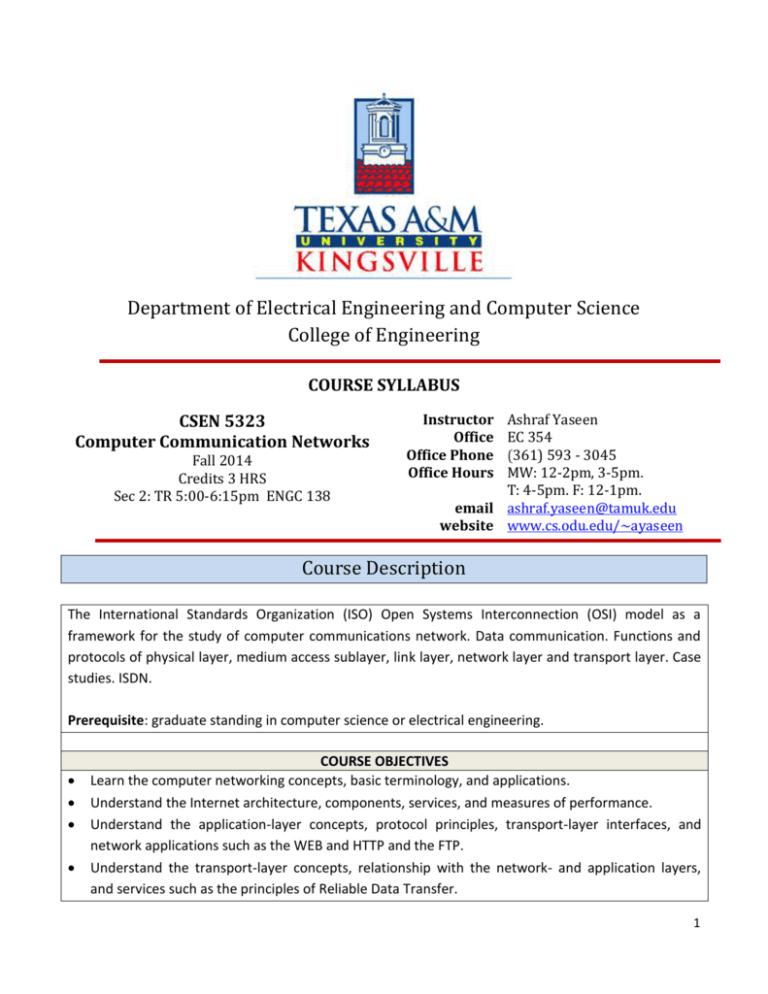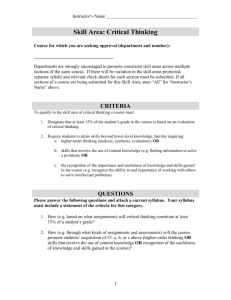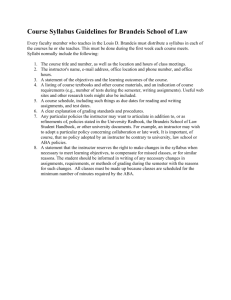
Department of Electrical Engineering and Computer Science
College of Engineering
COURSE SYLLABUS
CSEN 5323
Computer Communication Networks
Fall 2014
Credits 3 HRS
Sec 2: TR 5:00-6:15pm ENGC 138
Instructor
Office
Office Phone
Office Hours
Ashraf Yaseen
EC 354
(361) 593 - 3045
MW: 12-2pm, 3-5pm.
T: 4-5pm. F: 12-1pm.
email ashraf.yaseen@tamuk.edu
website www.cs.odu.edu/~ayaseen
Course Description
The International Standards Organization (ISO) Open Systems Interconnection (OSI) model as a
framework for the study of computer communications network. Data communication. Functions and
protocols of physical layer, medium access sublayer, link layer, network layer and transport layer. Case
studies. ISDN.
Prerequisite: graduate standing in computer science or electrical engineering.
COURSE OBJECTIVES
Learn the computer networking concepts, basic terminology, and applications.
Understand the Internet architecture, components, services, and measures of performance.
Understand the application-layer concepts, protocol principles, transport-layer interfaces, and
network applications such as the WEB and HTTP and the FTP.
Understand the transport-layer concepts, relationship with the network- and application layers,
and services such as the principles of Reliable Data Transfer.
1
Understand the network-layer concepts and routing principles, algorithms, and protocols.
Understand the data link-layer concepts, protocols, and services such as error-detection and
correction, addressing, and multiple-access techniques.
Learn the main concepts of wireless and mobile networks.
LEARNING OUTCOMES
Upon successful completion of this course, students are expected to gain the following skills:
List the five layers of the Internet protocol stack and give an example of each.
Define the roles of the major components of the computer networks and the Internet such as the
host, router, network application, protocol, and network services.
Use the basic computer networking terminology to describe the different components, services,
and applications provided of the Internet.
Describe the main design issues related to network engineering such as scalability, reliability,
efficiency, and cost-effectiveness.
Explain what happens on the network when you open a web page or click a link on a web page.
Explain how an email message you send to a friend is sent and delivered.
List the two main types of routing algorithms and which protocols use those algorithms.
Compute the end-to-end delay for a packet given the propagation delay, link bandwidth, and
packet size.
Explain the difference between congestion control and flow control and how each is implemented
in TCP
Write basic network applications using sockets. (for example, chat, echo, a web client, and an FTP
client)
Differentiate between the addressing information used in each network layer and their
corresponding functions such as port numbers, IP addresses, and MAC addresses.
While this course has specific learning outcomes which are described above, the following TAMUK’s
institutional learning outcomes will also be reinforced throughout the course through activities and
assignments:
Effective Communication skills (written and verbal communication)
Critical Thinking Skills
Application of the Scientific Process
Computer Networking: A Top-Down Approach Featuring the Internet, 6th edition, by
James F. Kurose and Keith W. Ross, Addison Wesley, 2012. ISBN: 9780132856201
REFERENCES
W. Stallings, "Data and Computer Communications", Upper Saddle River, NJ: Prentice Hall, 2011.
W. Stallings, “Computer Networking with Internet Protocols and Technology”, Upper Saddle River,
TEXTBOOK
2
NJ: Prentice Hall, 2004.
Chwan-Hwa Wu and J. David Irwin, “Introduction to Computer Networks and Cybersecurity”, New
York: CRC Press, 2013.
Homework
Assignments
Programming
Assignments
Report/
Presentation
Examinations
METHODS OF ASSESSMENT
There will be homework assignments given during the semester. All homework
assignments are due at the beginning of the class period on the due date. All
homework assignments are to be typed and submitted in class on the due date. If
an assignment is not submitted by the end of class on the due date, it is considered
late. All homework assignments should follow the format specified in the syllabus
attachment entitled “Homework Assignment Template”.
Each student will complete a number of programming assignments during the
semester. All programming assignments are due at the beginning of the class period
on the due date.
In addition to homework, each student group will be required to write a report and
present it. If the report is not submitted by the end of class on the due date, it is
considered late. Each report is worth 10 points toward the student’s final grade. All
reports should follow the format specified in the syllabus attachment entitled
“Report Template”.
There will be in-class tests given during the semester. Makeup exam should not be
given unless there is a valid excuse according to TAMUK policies. Arrangements to
take an exam at a time other than the one scheduled MUST be made prior to the
scheduled exam time.
GRADING SYSTEM
For each assignment, recitation, and test, a numerical grade is recorded,
Activities/ Number Percentages
Evaluation Methods
>=90%
Midterm Exam
1
25%
80-89%
Homework
6
30%
70-79%
Quizzes
6
15%
60-69%
Final Exam
1
30%
<60%
Total
100%
A
Excellent
B Very Good
C
Good
D
Failed
F
Failed
Methods of evaluations, grading policy and course schedule subject to change to better enhance the
students’ performance.
3
Course Schedule
Week
Topic
Reading
1
Course Description (Syllabus) & Overview
2
Introduction
CH-1
3, 4, 5
Application Layer
CH-2
6,7, 8
Transport Layer
CH-3
9,10, 11
The Network Layer
CH-4
12, 13, 14
The Link Layer
CH-5
15
Wireless and Mobile Networks
CH-6
16
Final Exam Review
Course Policies
Attendance Policy
Regular attendance is needed for your success in this course.
You are expected to consult with me whenever an absence is necessary.
Make-up exams
Make-ups for missed exams are granted only for excused (official university) absences
Cell Phones
Students should turn off and stow their cell phones during class.
Late Assignment
The penalty for a late assignment is 10 percent deduction for each day late. For example, if your
assignment grade is 92 and you submitted two days late, then your assignment grade would be
72. No assignment will be accepted after 2 days late.
4
University Policies
DISABILITY STATEMENT
The Americans with Disabilities Act (ADA) is a federal anti-discrimination statute that provides
comprehensive civil rights protection for persons with disabilities. Among other things, this legislation
requires that all students with disabilities be guaranteed a learning environment that provides for
reasonable accommodation of their disability. If you believe you have a disability requiring an
accommodation please contact the Disability Resource Center (DRC) as early as possible in the term at
(361) 593-2904. DRC is located in the Life Service and Wellness building at 1210 Retama Drive.
SIX-DROP POLICY
The following provision does not apply to students with Texas public college or university credits prior
to Fall 2007. The Texas Senate Bill 1231 specifies the number of course drops allowed to a student
without penalty. After a student has dropped six courses, a grade of QF will normally be recorded for
each subsequent drop. Additional information on Senate Bill 1231 is available at the Registrar’s Office
at (361) 593-2811 and at http://www.tamuk.edu/registrar/drop_policy.html.
ACADEMIC MISCONDUCT STATEMENT
You are expected to adhere to the highest academic standards of behavior and personal conduct in this
course and all other courses. Students who engage in academic misconduct are subject to university
disciplinary procedures. Make sure you are familiar with your Student Handbook, especially the
section on academic misconduct, which discusses conduct expectations and academic dishonesty rules.
Forms of academic dishonesty:
1) Cheating: Using unauthorized notes or study aids, allowing another party to do one’s work/exam
and turning in that work/exam as one’s own; submitting the same or similar work in more than one
course without permission from the course instructors; deception in which a student misrepresents
that he/she has mastered information on an academic exercise that he/she has not mastered;
giving or receiving aid unauthorized by the instructor on assignments or examinations.
2) Aid of academic dishonesty: Intentionally facilitating any act of academic dishonesty. Tampering
with grades or taking part in obtaining or distributing any part of a scheduled test.
3) Fabrication: Falsification or creation of data, research or resources, or altering a graded work
without the prior consent of the course instructor.
4) Plagiarism: Portrayal of another’s work or ideas as one’s own. Examples include unacknowledged
quotation and/or paraphrase of someone else’s words, ideas, or data as one’s own in work
submitted for credit. Failure to identify information or essays from the Internet and submitting
them as one’s own work also constitutes plagiarism.
5) Lying: Deliberate falsification with the intent to deceive in written or verbal form as it applies to an
5
academic submission.
6) Bribery: Providing, offering or taking rewards in exchange for a grade, an assignment, or the aid of
academic dishonesty.
7) Threat: An attempt to intimidate a student, staff or faculty member for the purpose of receiving an
unearned grade or in an effort to prevent reporting of an Honor Code violation.
Please be aware that the University subscribes to the Turnitin plagiarism detection service. Your paper
may be submitted to this service at the discretion of the instructor.
Other Forms of Academic Misconduct:
1) Failure to follow published departmental guidelines, professor‘s syllabi, and other posted academic
policies in place for the orderly and efficient instruction of classes, including laboratories, and use
of academic resources or equipment.
2) Unauthorized possession of examinations, reserved library materials, laboratory materials or other
course related materials.
3) Failure to follow the instructor or proctor‘s test-taking instructions, including but not limited to not
setting aside notes, books or study guides while the test is in progress, failing to sit in designated
locations and/or leaving the classroom/ test site without permission during a test.
4) Prevention of the convening, continuation or orderly conduct of any class, lab or class activity.
Engaging in conduct that interferes with or disrupts university teaching, research or class activities
such as making loud and distracting noises, repeatedly answering cell phones/text messaging or
allowing pagers to beep, exhibiting erratic or irrational behavior, persisting in speaking without
being recognized, repeatedly leaving and entering the classroom or test site without authorization,
and making physical threats or verbal insults to the faculty member, or other students and staff.
5) Falsification of student transcript or other academic records; or unauthorized access to academic
computer records.
6) Nondisclosure or misrepresentation in filling out applications or other university records.
7) Any action which may be deemed as unprofessional or inappropriate in the professional
community of the discipline being studied.
Non-academic misconduct:
The university respects the rights of instructors to teach and of students to learn. Maintenance of
these rights requires campus conditions that do not impede their exercise. Campus behavior that
interferes with these rights will not be tolerated; examples include
1) interfering with the instructor's ability to conduct the class,
2) causing inability of other students to profit from the instructional program, or
3) any interference with the rights of others.
An individual engaging in such disruptive behavior may be subject to disciplinary action. Such incidents
will be adjudicated by the Dean of Students under non-academic procedures.
Ongoing behaviors or single behaviors considered distracting (e.g., coming late to class, performing a
6
repetitive act that is annoying, sleeping or reading a newspaper in class, etc.) will be addressed by the
faculty member initially either generally or individually. Cases in which such annoying behavior
becomes excessive and the student refuses to respond to the faculty member‘s efforts can be referred
to the Dean of Students. In the case of serious disruptive behavior in a classroom the instructor may
first request compliance from the student and if it is not received, an instructor has the authority to ask
the student to leave the classroom. If the student fails to leave after being directed to do so, assistance
may be obtained from other university personnel, including University Police Department. An
individual engaging in such disruptive behavior is subject to disciplinary action. Such incidents will be
adjudicated by the Dean of Students under non-academic procedures to determine if the student
should be allowed to return to the classroom.
HARASSMENT /DISCRIMINATION
Texas A&M University-Kingsville does not tolerate discrimination on the basis of race, color, religion,
national origin, age, disability, genetic information, gender, gender identity or sexual orientation (or
any other illegal basis) and will investigate all complaints that indicate sexual harassment, harassment,
or discrimination may have occurred. Sexual harassment and sexual assault are types of sex
discrimination. Such sexual misconduct is unacceptable and will not be tolerated. Any member of the
university community violating this policy will be subject to disciplinary action. A person who believes
he/she has been the victim of sexual misconduct harassment, harassment, or discrimination may
pursue either the informal or the formal complaint resolution procedure. A complaint may be initially
made to the Office of Compliance at (361) 593-4758, complainant’s immediate supervisor, a
department head, a supervisory employee, or the Dean of Students at (361)-593-3606 or the Office of
Compliance at (361) 593-4758. Regardless of who the complaint is filed with, the Compliance Office
will be notified of the complaint so it can be investigated.
AMENDMENTS TO SYLLABUS
This syllabus provides a general plan for the course. The instructor reserves the right to amend this
syllabus at any time. Any such change will be announced, and distributed to the class. As with all
other class requirements, the student is responsible for being present to receive such changes or to
refer to Blackboard to view the changes
7







